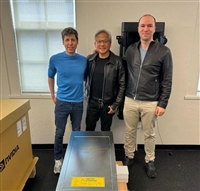AN313
USING THE Si3400 AND Si3401 IN HIGH POWER APPLICATIONS
support of 15 W output power will require a minimum
hot swap switch current limit of about 470 mA. The
1. Introduction
Emerging Power over Ethernet (PoE) applications, such
Si3401 supports a minimum hot swap current limit of
as multi-band and 802.11n access points, often require
470 mA.
more power than the 12.95 W specified by the IEEE
For a typical 5 V isolated application, the dissipation of
802.3af. This application note outlines how to use the
the Si3400 and Si3401 is 1.2 W for the maximum power
Si3400 and Si3401 to support powered device (PD)
of 10 W output with 12.95 W input power. This results in
applications over 15 W output, which corresponds to
a thermal rise of 54 °C (plus heating due to other
about 20 W of input power from the PSE.
components), which is close to the typical 160 °C
The current standard for Power over Ethernet or PoE is
thermal shutdown temperature specification of the
IEEE Std™ 802.3-2005, clause 33. Although there is
Si3400 and Si3401 when the ambient temperature is
currently no ratified standard beyond this, a standard,
85 °C. While the Si3400 and Si3401 are designed to
commonly referred to as PoE+, is being actively
handle the 12.95 W power level, there is simply too
developed in the p802.3at subcommittee. While this
much power dissipation in the Si3400 and Si3401
note attempts to be consistent with the general direction
packages when used beyond this currently-specified
in discussion by the p802.3at committee, it should be
limit. To work around this, it is possible to bypass the
emphasized that no standard currently exists to support
Si3400’s and Si3401's two internal diode bridges using
power above the current specification's 12.95 W
maximum of power available at the PD. The proposed
the circuit shown in Figure 1.
solutions in this document are intended to serve as
practical solutions for higher power PDs before p802.3at
Vposf
is ratified.
Based on current discussions in the p802.3at
committee, it appears likely that the minimum PSE
CT1
CT2
Si3400
Si3401
output voltage will be increased, and the maximum
cable resistance will be decreased to support PoE Plus.
It is also likely that there will be a provision for
classifying at the current maximum supported power of
12.95 W input and then negotiating with the PSE for
higher power via a simple data exchange with the
Ethernet switch using, for example, the 802.3 (LLDP)
layer.
SP1
SP2
Vneg
Figure 1. Internal Diode Bridge Bypass
It is recommended that the diode bridges internal to the
Si3400 and Si3401 remain connected so as to allow the
early power loss feature (PLOSS signal) to remain
active. Low-cost diodes, such as 1N4002, can be used
to bypass the diodes on the Si3400 and Si3401
because they have a slightly lower voltage drop. This
will help spread the heat in higher power applications.
For higher efficiency, Schottky diodes can be used. It is
also possible to use just the upper four or lower four
diodes for half the benefit at half the cost.
2. Power and Thermal
Considerations
The Si3400 and Si3401 were intentionally designed with
"hot swap" switch current limits well above the 350 mA
maximum current specification of 802.3af so as not to
limit the PD from drawing more power from a PSE as
long as the PSE is capable of providing the power. The
typical value is 525 mA for the Si3400 and 550 mA for
the Si3401. Also, the switcher FET is designed for
current levels of up to 4 A with a very low on-resistance
Using the full bypass, the power in the Si3400 and
Si3401 is reduced to 0.5 W at 5 V/2 A output and
0.83 W at 5 V/3 A (15 W) output. Both of these power
levels are well within the thermal capability of the
Si3400 and Si3401 packages.
of 0.5
Ω (typical). What this means is that the Si3400
and Si3401 are capable of operating at higher power
levels, subject to thermal constraints and proper thermal
management on the PCB. While the exact voltage and
cable resistance have not yet been determined for the
PoE+ or 802.3at applications, it is estimated that
With the one-half bypass, the power in the Si3400 and
Si3401 packages is at the 1.2 W maximum for a 5 V/
2.6 A (13 W) load.
Rev. 0.2 12/06
Copyright © 2006 by Silicon Laboratories
AN313






 全球首块英伟达H200交付 黄仁勋“送货上门”
全球首块英伟达H200交付 黄仁勋“送货上门”

 常用8脚开关电源芯片型号大全
常用8脚开关电源芯片型号大全

 74HC04芯片引脚图及功能、应用电路图讲解
74HC04芯片引脚图及功能、应用电路图讲解

 CR6842芯片参数、引脚配置、应用电路图详解
CR6842芯片参数、引脚配置、应用电路图详解
